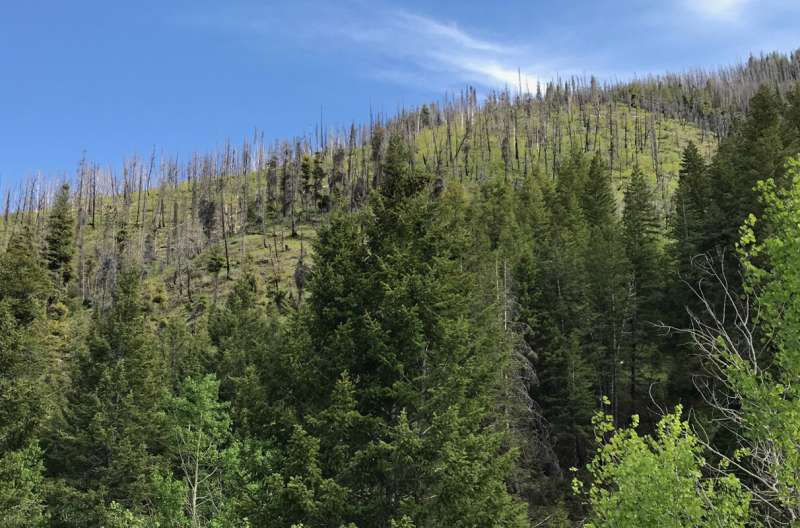This article has been reviewed according to Science X's editorial process and policies. Editors have highlighted the following attributes while ensuring the content's credibility:
fact-checked
trusted source
proofread
Modeling study shows how bark beetle infestations affect wildfires

A recent modeling study shows that bark beetle outbreaks in forests won't necessarily cause bigger and more damaging wildfires—at least not for awhile.
The research could someday help fire managers better decide on how to dedicate resources in fighting fires and removing fuel. In particular, the researchers hope that managers can better assess where, when, and how they should allocate resources when there is a beetle outbreak in a forest.
"There's a common perception among the community that bark beetle infestations will most definitely increase fire," said Jennifer Adam, Berry Family Distinguished Professor in Washington State University's Department of Civil and Environmental Engineering. "But the importance of this paper is the fact that the answer to that question is that it depends. If you just look at the effects of climate change directly on fires, fire spread, or fire probability and you don't include vegetation in the picture, you get the wrong answer most of the time."
Led by Jianning Ren, a postdoctoral fellow at University of Nevada, Reno, and Adam, the researchers published their work on the bark beetle's effects on wildfires in the Journal of Advances in Modeling Earth Systems.
Climate change is intensifying natural disturbances such as wildfire, extreme weather events, and insect outbreaks, and in recent years bark beetle outbreaks have affected millions of hectares of forest in the western U.S. and Canada. The bark beetle kills trees, but it's been unclear how this affects wildfires—some studies find increases in fires after beetle attacks while others found no increase.
That's because trying to tease out the myriad different factors affecting wildfires in the field is challenging.
"Figuring out when and where beetles will increase or decrease fire is almost impossible using field observations because we just don't have all the different combinations of all the different factors," said Erin Hanan, a co-author on the paper and assistant professor at the University of Nevada, Reno. "A model is useful when we're trying to understand complex interactions because we can hold everything constant and just turn one dial—like how wet it is or how much mortality we have. Not surprisingly the answer was really complicated."
In their study, the researchers studied the Trail Creek watershed in the Big Wood River basin in Idaho. They found that during the first five years or so of a bark beetle outbreak, bark beetle damage might actually limit the spread of ground wildfires. That's because wildfires are affected by two factors—how dry the fuel is and how much fuel there is.
In the first three to five years after an attack, the trees that have been killed by the beetles remain standing with their needles intact, turning from green to a sickening red. With a less productive forest and the normal detritus that would accumulate on a forest floor, fires have less fuel to burn, and the chance of ground fires decreased. After a few years, though, the needles fall off the dead trees, leaving a gray forest. In many cases, the fires then increased.
The likelihood of and extent of forest fires is also determined by how many trees actually die in an outbreak, another hard-to-measure variable. Furthermore, the moisture level of fuels and soils changes to varying degrees as trees die, which also impacts fires.
"When you have bark beetles come in, they're killing trees and they're changing fuels in multiple different ways," said Hanan. "They're not only creating a lot of dead fuel in the landscape, but they're also changing the way trees use water."
Because it's a modeling study, the research doesn't specifically predict what's going to happen in real fires. The models, for instance, don't include any fire suppression efforts. Rather, the work is fundamental research that aims to disentangle the many variables affecting forest fires and to help researchers get a better understanding of the natural processes that will occur.
"With our modeling tool, fire managers can run simulations and then decide the most effective way to reduce the fire risk," said Ren, who received his Ph.D. at WSU. "This research provides a practical tool for managers to better predict when and where fire hazards will increase."
More information: Jianning Ren et al, Bark Beetle Effects on Fire Regimes Depend on Underlying Fuel Modifications in Semiarid Systems, Journal of Advances in Modeling Earth Systems (2023). DOI: 10.1029/2022MS003073
Provided by Washington State University



















